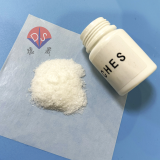Chinese VersionChina Suppliers > Hubei new DE sheng material science and technology co., LTD. > Buffering range and advantages of 2-cyclohexylaminoethanesulfonic acid (CHES)
- Search Product
-
-
- Region :China/Hubei
- Tel : +86-18971041571
- Fax :
- Email :vickyzhao@whdschem.com
- URL :
- Add :Guanggu United Science and Technology City C8, Ezhou City, Hubei Province
- Details for Buffering range and advantages of 2-cyclohexylaminoethanesulfonic acid (CHES)
-
Buffering range and advantages of 2-cyclohexylaminoethanesulfonic acid (CHES)
Category : Other Chemicals/Others

CAS NO : 103-47-9 EC NO : 203-115-6 MF : C8H17NO3S MW : 207.2905 Specification : White Powder Packing : 500g/bottle Product description : 2-cyclohexylaminoethanesulfonic acid (CHES) is a commonly used buffer used in biochemical and molecular biology experiments to maintain the stability of solutions within a specific pH range. Although it appears less frequently in the buffering agent family, its buffering range enables it to play a role in many fields and has certain advantages. It is crucial for experimenters to correctly understand and use the buffering range of CHES buffering agents for the success of experiments. So now we will delve into the buffering range and advantages of 2-cyclohexylaminoethanesulfonic acid. 1、 Buffer range of CHES buffer CHES is a zwitterionic buffer with a buffering range of pH 8.6-10.0 in the alkaline range, and a pKa (acid dissociation constant) of approximately 9.5. At this pKa value, CHES can stabilize the pH of the buffer solution within a certain range, providing assurance for experimental results. 2、 The advantages of CHES buffer 1. Good stability: CHES buffer has good stability within its working range and can maintain a stable pH value in biochemical experiments. 2. High compatibility with biological systems: The pH range of CHES is suitable for many biological systems and is therefore widely used in many biological experiments, such as enzyme catalyzed reaction buffer solutions. 3. Strong effectiveness: Due to the characteristics of CHES buffer range, it can effectively buffer under alkaline conditions, meeting specific experimental needs, such as samples and running buffer solutions for various capillary electrophoresis. 3、 Notes on CHES buffer 1. Not suitable for low pH experiments: Due to the high pKa value of CHES, it is not suitable for experiments that require lower pH values. 2. Mixing with other buffering agents should be avoided: when mixed with other buffering agents, it may cause pH instability and affect experimental results. 3. Suitable buffering agents should be selected according to experimental needs: Although CHES performs well within a certain range, in some specific experiments, it may still be necessary to choose other buffering agents that better meet the requirements to achieve better results. 2-cyclohexylaminoethanesulfonic acid (CHES), as a commonly used buffering agent, performs well in the pH range of 8.6-10.0. Reasonable selection and use of CHES buffer can ensure the stability of the solution in biochemical experiments, providing assurance for the accuracy and reliability of experimental results. However, when choosing a buffer, it is necessary to choose a buffer with stable quality according to the specific requirements and conditions of the experiment to achieve better experimental results. As an advantageous supplier of CHES, Desheng can provide high-quality raw material powders, which are convenient for transportation and storage, and are affordable. Many people in the market choose to cooperate with us. If you are also interested, why not contact us and give it a try! Uses : Biological buffer Synonyms : CHES;N-Cyclohexyltaurine;2-(Cyclohexylamino)ethane sulfonic acid; Molecular Structure : 
- more>>Other Products
-
- • Biological buffer 3- [N, N-di (hydroxyethyl) amino] -2-hydroxypropanesulfonic acid DIPSO
- • Luminol Sodium Salt
- • 4-Aminophthalhydrazide
- • acridinium ester DMAE-NHS
- • acridinium ester NSP-DMAE-NHS
- • Acridine hydrochloride NSP-SA
- • Acridine hydrochloride NSP-SA-NHS
- • NSP-SA-ADH
- • acridinium ester ME-DMAE-NHS TOOS; 3-(N-Ethyl-3-Methylanilino)-2-Hydroxypropanesulfonic Acid Sodium Salt
- • TOPS; Sodium 3-(N-Ethyl-3-Methylanilino)Propanesulfonate; N-Ethyl-N-Sulfopropyl-M-Toluidine Sodium Salt
- • ADOS Sodium 3-(Ethyl(3-Methoxyphenyl)Amino)-2-Hydroxypropane-1-Sulfonate Dihydrate
- • ADPS N-Ethyl-N-(3-Sulfopropyl)-3-Methoxyaniline Sodium Salt
- • ALPS N-Ethyl-N-(3-Sulfopropyl)Aniline Sodium Salt; Sodium 3-(Ethyl(Phenyl)Amino)Propane-1-Sulfonate; Sodium
- • DAOS; Sodium 3-((3,5-Dimethoxyphenyl)(Ethyl)Amino)-2-Hydroxypropane-1-Sulfonate
- • HDAOS; N-(2-Hydroxy-3-Sulfopropyl)-3,5-Dimethoxyaniline Sodium Salt
- • MADB N,N-Bis(4-Sulfobutyl)-3,5-Dimethylaniline Disodium Salt
- • MAOS N-Ethyl-N-(2-Hydroxy-3-Sulfopropyl)-3,5-Dimethylaniline Sodium Salt Monohydrate
- • DAB 3,3',4,4'-Biphenyltetramine Tetrahydrochloride